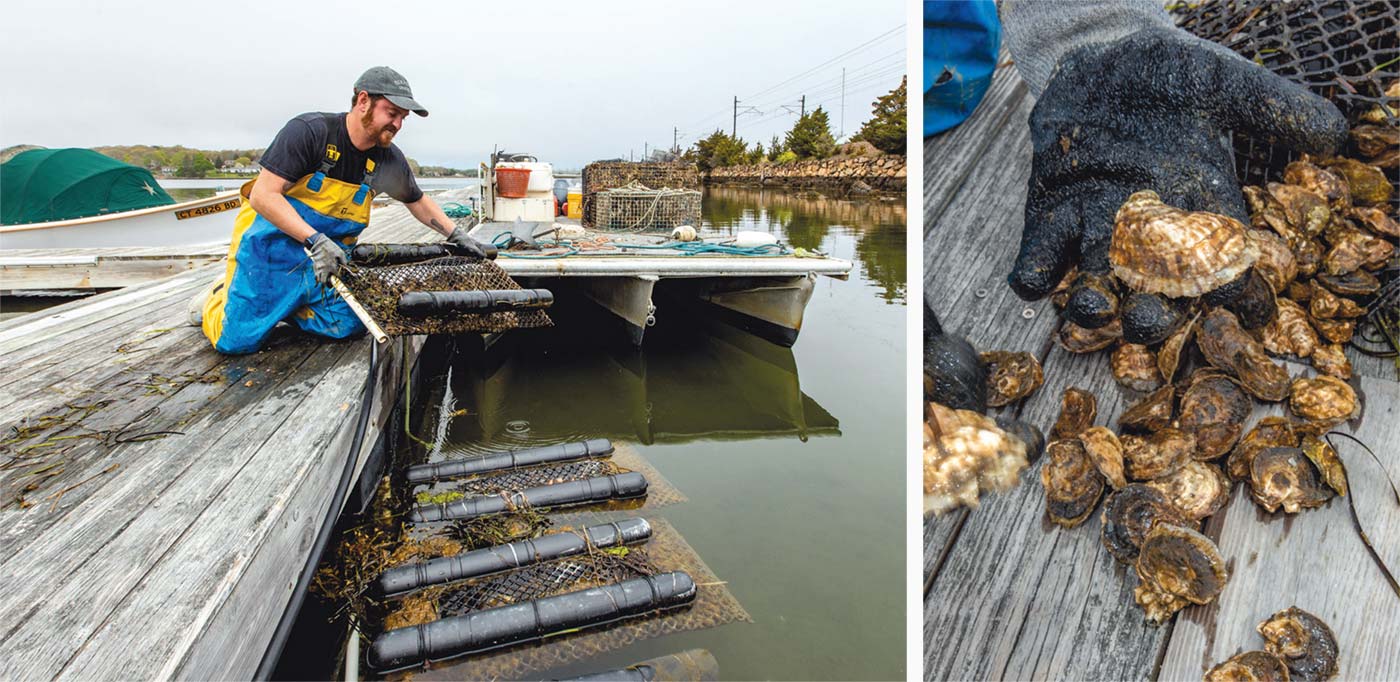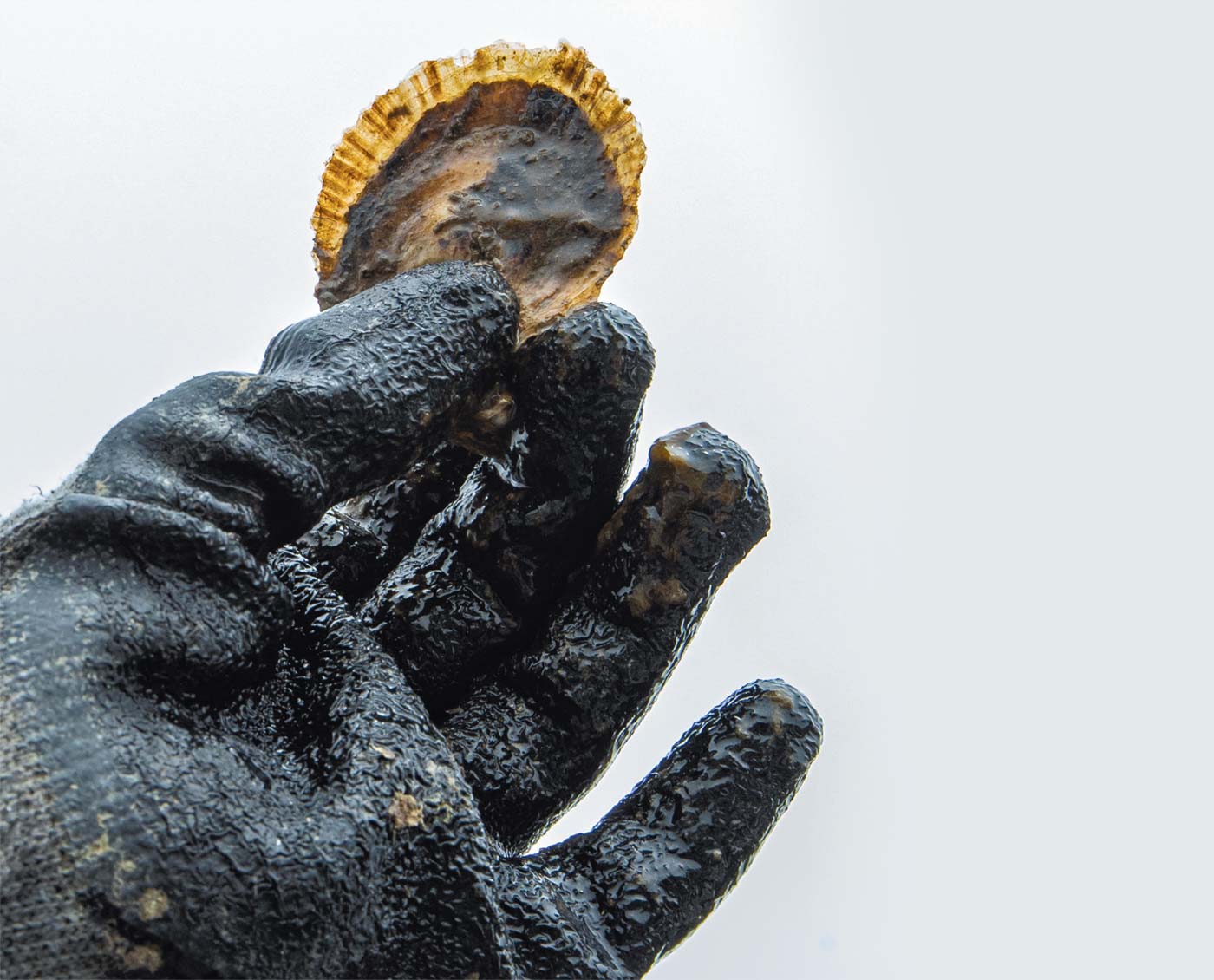The Magic of Oysters

(All at Mystic Oysters unless noted) Sorting oysters - large ones will be kept and small ones are tossed back to continue to grow
Along the shoreline, a plate of oysters with mignonette sauce is sacrosanct. An unfussy dish that instantly adds a touch of glam to any ordinary day. Yet, it’s not simply for their taste that those in the know prize oysters.
“Oysters can filter up to 50 gallons of water a day,” says Marc Harrell of Mystic Oysters. “The more oysters that we’re able to produce and plant in the Sound, the Mystic, and Noank, the better the water quality.”
As the climate crisis intensifies, oysters are finally getting their due not only as delicious but also as ecological powerhouses. They are one of the most environmentally friendly and sustainable protein sources, create habitat for other marine life, help prevent coastal flooding and erosion, and contribute to preserving working waterfronts.
“Here in Connecticut oysters are a great source of local healthy food. They provide jobs and income and they also provide all of these other ecosystem services,” says Aquaculture Extension Educator Tessa Getchis of the Connecticut Sea Grant and UConn Extension Program.
As water passes through an oyster, the shellfish removes nutrients from the water by eating microscopic plants, phytoplankton, and tiny bits of algae which can help reduce algae blooms. Algae blooms which can make people sick and be deadly for animals occur when there are too many nutrients such as nitrogen or phosphorus in the water. When oysters eat, they convert excess nutrients into their body tissue, filtering out the now clean water over their gills.
“Think of sea water which is often murky from sediment. If you fill a fish tank with sea water and add a dozen oysters it’ll be completely clear within a couple of hours,” says Tessa. It’s also why oysters grown even just a mile apart or oysters grown on the same bed but during different years can have such radically different tastes—their flavors, a direct result of their hyperlocal aquatic environment. Oyster farmers call this the merrior.

(top left) Nursery Manager Danielle Buttermore, checks the algae growing in tanks, the algae is fed to the oysters in the nursery; (top right) Owner Jim Markow; (bottom left) Will Ceedia from Sixpenny Oyster Farm sorting oysters; (bottom right) the Mystic boat sits ready to hit the oyster beds; Danielle Buttermore opens a freshly harvested oyster
It’s not simply the water quality, though; oyster reefs protect the shoreline from erosion and can dampen the energy from intense storms. And their habitats anchor other marine life in the area, including fish, snails, and crabs.
Connecticut has long been at the forefront of oyster preservation and restoration. In the late 1800s, the state protected oysters by placing restrictions on the number, size, and even timing of oyster harvests. Those protections have primarily worked. The state is one of the top oyster producers in the country and one of the few that relies mainly on natural oyster beds for oyster seeds. Those beds have sustained the oyster industry for more than 100 years thanks in large part to oyster farmers in the state that focus on sustainability.
“We love growing; we love farming,” says Will Ceddia, who farms oysters in Beebe Cove in Noank. “We want to grow sustainably, keep it small and manageable and have a fun time doing it while being a part of the community.”
As part of being that part of the community, both Ceddia at Sixpenny and Harrell at Mystic Oysters are working towards doing tours of their oyster farms in the near future to get people out on the farms, learn about the magic of oyster farming, and of course taste a few.
“They have a phenomenal environmental impact. We’re lucky to grow food while also doing the best environmentally for our planet that we can,” says Marc.

(left) Will Ceddia from Sixpenny Oyster Farm pulling bags, in which the oysters grow, from the water; (right) sorting oysters on the dock.
THE CT SHORELINE BOASTS DOZENS OF OYSTER FARMS AND VARIETIES. A FEW FAVORITES INCLUDE:
- Mystic Oysters: For more than two decades, Mystics have been farmed at the mouth of the Mystic River. Inside the green-hued shells, you’ll find plump, creamy oysters with a bit of salty brine mingling with sweetness.
- Sixpenny Oyster Farm: One of the newer additions to the shoreline’s oyster selections, Sixpennies have quickly become a favorite of professional and home chefs. The oyster farm located in Beebe Cove produces fast-growing oysters that are tender and briny.
- Copps Island Oyster Farm: Down in Norwalk, fourth-generation Copps Island Oyster Farm, has several oyster varieties. If you favor a more petite, saltier oyster, you’ll want to get the White Rock, but why not also try the namesake Copps Island, a sweet, plump oyster farmed on the ocean floor.
- Fishers Island Oysters: One of the oldest oyster farms in the area, Fishers Island Oysters uses a suspension-culture system. Their oysters are known for their clean finish and bold, earthy notes.
- Indian River Shellfish Farm: You’ll find more than 3 million oysters of all ages on this 11-acre farm at the mouth of the Hammonasset River near Clinton and Madison. Depending on the time of year, you can get both farmed and wild oysters from Indian River Shellfish, and you should try them both. You’ll notice the wild ones are bigger and meatier.





